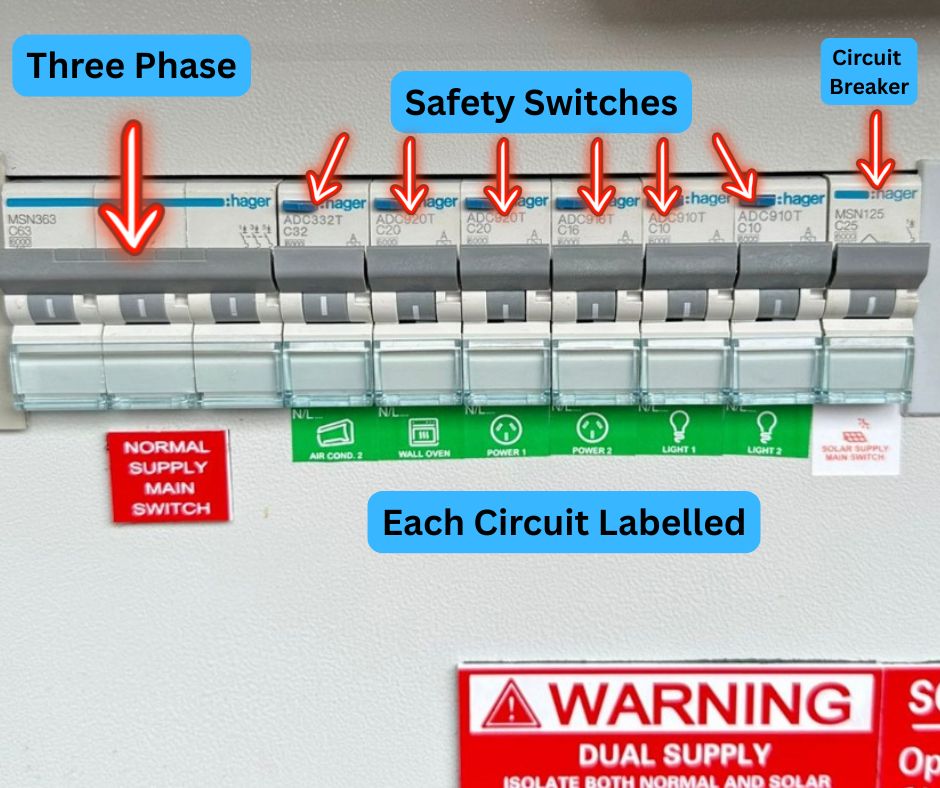High-power ducted air conditioning systems have the potential to dramatically enhance comfort levels within a Brisbane home. However, these systems generally require more electrical capacity than what is typically available from a single-phase supply. This highlights the necessity of a three-phase power upgrade. By switching to a three-phase system, homeowners can ensure that their air conditioning operates at optimal efficiency without putting undue strain on their existing electrical infrastructure, thus safeguarding their investment and enhancing overall comfort.
This comprehensive guide delves into the critical scenarios that warrant a three-phase upgrade, the significance it holds for air conditioning performance, and its relationship with solar power systems. This is especially relevant in Brisbane, where nearly half of all homes have solar panels installed. Understanding these factors can empower homeowners to make informed decisions about their electrical needs and ensure their systems operate efficiently and sustainably.

Understanding When Three-Phase Power Is Essential for Air Conditioning Systems
While many split system air conditioners and smaller ducted units can function effectively on a single-phase supply, larger ducted systems with a cooling capacity exceeding 12–15kW demand a considerable increase in power consumption. As the need for energy rises, the limitations of single-phase supply become apparent, potentially resulting in service interruptions and operational inefficiencies. It is crucial to recognise these challenges early to avoid complications later.
Three-phase power is designed to distribute electrical load evenly across three live wires rather than relying on a single phase. This sophisticated configuration provides several advantages, including:
- Higher capacity systems can function smoothly without tripping circuit breakers, significantly reducing the risk of system failures and ensuring uninterrupted cooling.
- Improved voltage stability enhances the efficiency and lifespan of the air conditioning unit, providing consistent performance even during peak usage times.
- Reduced strain on your entire electrical system, especially when other high-demand appliances are in use simultaneously, further contributing to the overall efficiency of your home.
If you are in the process of constructing a large new home or upgrading to a more powerful air conditioning model, opting for a three-phase supply may be the safest and most compliant method to meet your electrical demands in accordance with Australian Standards, thereby ensuring long-term reliability and performance.

Identifying Clear Indicators for a Three-Phase Power Upgrade in Your Air Conditioning System
- You are considering the installation of a ducted system that exceeds 12–15kW, necessitating a review of your current electrical capacity.
- Your electrician has indicated that your existing single-phase supply is insufficient to accommodate the required load for your new system.
- The specifications provided by the manufacturer of your air conditioning system clearly state that a three-phase power supply is essential.
- You frequently operate other high-demand appliances, such as substantial pool pumps, welders, or commercial kitchen equipment, concurrently with your air conditioning unit.
An electrical assessment carried out by a qualified electrician can provide clarity on whether your current electrical supply is adequate or if a three-phase upgrade would enhance reliability and performance over the long term, making it a worthwhile consideration for homeowners.
Exploring the Integration of Solar Power with Three-Phase Systems
With over half of Brisbane households now taking advantage of rooftop solar energy, many residents are looking for ways to expand their systems or connect them with high-power appliances, including ducted air conditioning systems. The synergy between solar power systems and three-phase upgrades can significantly improve energy efficiency and overall system performance, making it an essential consideration for modern homes.
Typically, residences on a single-phase supply in Australia face limitations, capped at around 5–6.6kW of solar inverter capacity due to the regulations imposed by most electricity distributors. For those planning to install a larger solar system, particularly those exceeding 10kW, transitioning to a three-phase connection may be necessary to comply with network requirements and avoid potential restrictions on energy export.
Utilising three-phase power also provides the following benefits:
- Balancing solar generation across phases, facilitating smoother grid export and enhancing the overall reliability of the system.
- Avoiding voltage rise issues that could lead to solar inverters tripping, ensuring consistent operation of your solar system.
- Supporting the operation of high-power appliances directly from solar energy without overloading any single phase, thereby maximising overall efficiency and sustainability.
If you’re contemplating the installation of both a large ducted air conditioning system and an expanded solar array, upgrading to three-phase power can provide substantial improvements in operational efficiency, ensure compliance with regulations, and optimise your ability to harness and utilise solar energy effectively for your home.
Step-by-Step Process for Upgrading to Three-Phase Power
The transition to three-phase power is generally a straightforward process, especially when overseen by a licensed electrician. The upgrade typically involves several key steps, ensuring that the new system integrates seamlessly with your existing electrical infrastructure:
- Assessment – Evaluating your home’s load requirements, the specifications of your air conditioning system, and any plans for solar energy integration to ensure compatibility and efficiency.
- Distributor application – Submitting a request for approval from your local energy network provider to ensure adherence to all relevant regulations and standards.
- Switchboard upgrade – Installing a compliant three-phase switchboard along with necessary circuit protection measures to guarantee safety and efficiency in your electrical supply.
- Final connection – Coordinating with your energy provider to establish the new three-phase supply, ensuring a smooth transition without disruptions.
At Precision Electrical & Air, we are dedicated to managing the entire upgrade process from start to finish, ensuring that your air conditioning and solar systems are equipped to meet the demands of modern living and energy requirements effectively, while providing peace of mind and reliability for homeowners.

Key Benefits of Upgrading to Three-Phase Power for Enhanced Air Conditioning Performance
Investing in a high-power ducted air conditioning system, particularly in conjunction with a significant solar installation, means that opting for three-phase power is not merely an upgrade; it signifies a commitment to reliability and performance in your home. This enhancement ensures stable operation, drastically reduces the risk of electrical complications, and provides the necessary capacity to operate your comfort systems without any compromises, leading to greater satisfaction and efficiency.
We specialise in the installation, upgrading, and maintenance of three-phase switchboards throughout Brisbane, ensuring seamless integration with solar and battery systems. Whether you are in the process of building a new home, renovating, or retrofitting an existing property, our expert team will design an electrical solution tailored to keep your home comfortable, energy-efficient, and well-prepared for the future.
The Article: Three-Phase Switchboard: Is It Essential for Air Conditioning? first appeared on https://writebuff.com
The Article Three-Phase Switchboard: Essential for Air Conditioning? Was Found On https://limitsofstrategy.com

